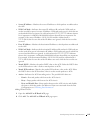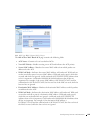
194 Configuring Switch Information
www.dell.com | support.dell.com
• Set Port—Indicates that the port is either locked or unlocked. The possible field
values are:
– Unlocked—Unlocks Port. This is the default value.
– Locked—Locks Port.
• Action on Violation—Indicates the action to be applied to packets arriving on a
locked port. The possible field values are:
– Forward—Forwards the packets from an unknown source; however, the MAC
address is not learned.
– Discard—Discards the packets from any unlearned source. This is the default
value.
– Shutdown—Discards the packet from any unlearned source and locks the port.
Ports remain locked until activated or the device is reset.
• Trap—Enables sending a trap. The possible field values are:
– Enable—Enables traps being sent when a packet is received on a locked port.
– Disable—Disables traps being sent when a packet is received on a locked port.
This is the default value.
• Trap Frequency (1-1000000)—Indicates the amount of time (in seconds) between
traps. This field only applies to locked ports. The default value is 10 seconds.
Defining a Locked Port:
1 Open the Port Security page.
2 Select an interface type and number.
3 Define the Set Port, Action on Violation, and Trap fields.
4 Click Apply Changes. The locked port is added to the Port Security Table, and the
device is updated.
Displaying the Locked Port Table:
1 Open the Port Security page.
2 Click Show All. The Port Security Table page opens. The fields in the Port Security
Tab le are the same as the fields in the Port Security page. Locked Ports can also be
defined from the Locked Ports Table as well as the Port Security page.


















